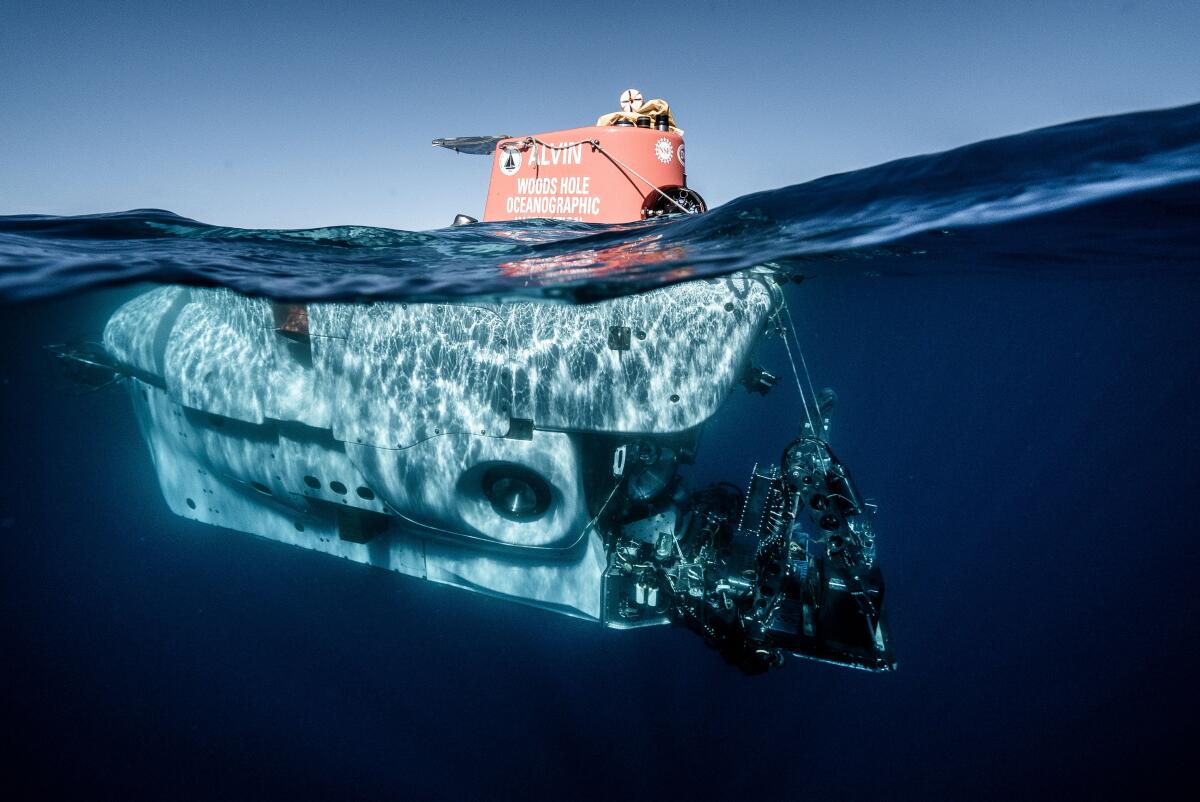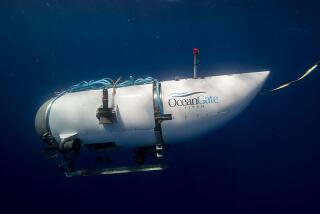The mini-sub that carried the first humans to the Titanic is in San Diego looking for fresh discoveries

- Share via
SAN DIEGO — Alvin, the famous research submarine that revolutionized science’s understanding of the deep oceans and took the first human explorers to the wreckage of the Titanic, has a temporary new home: San Diego.
The three-person submersible, which is owned by the Navy and operated by the Woods Hole Oceanographic Institution in Massachusetts, arrived in June and will stay until late July or early August.
The institution periodically works from UC San Diego’s large marine facility in San Diego Bay as a base when it is conducting research in Southern California.
Scientists from UCLA and UC Santa Barbara are currently using Alvin to do seafloor sampling in the Santa Barbara Basin, where there is a rich mix of marine life despite a constant and natural seepage of oil from the bottom.
In mid-July, they’ll hand Alvin over to Lisa Levin, a marine ecologist at UCSD’s Scripps Institution of Oceanography who has taken more than 50 trips aboard Alvin. Levin specializes in studying biodiversity and ecosystems, notably methane seeps.
In early August, Alvin’s engineers will spend several days conducting training exercises off San Diego, many of which are devoted to the safe operation of a sub that can descend nearly 4 miles deep.
The safety of submersibles received international attention last month when Titan, a tourist-oriented vessel with an experimental hull, imploded underwater off Newfoundland, Canada, as it was trying to dive down to the Titanic. The accident killed all five of Titan’s passengers, and it led to disclosures that many deep-sea explorers and oceanographers were concerned about the safety of the sub’s experimental design.
Bruce Strickrott, an Alvin pilot, declined Thursday to make comparisons between his submarine and Titan, which was owned by OceanGate, a tourism and expedition company.
Instead, he spoke about Alvin’s rigorous design and operation standards.
“About 60% of the sub is Navy-certified,” Strickrott said. “These are systems that are critical to the life and safety of the occupants — things like life support, windows, the flotation foam.”
The Woods Hole Oceanographic Institution added that Alvin, which has performed more than 5,100 dives, is taken out of service every five years, disassembled, inspected and reassembled, then goes through recertification by the Navy.
The original Alvin was commissioned in 1964 and made a major contribution two years later when it located a 1.45 megaton hydrogen bomb that fell into the Mediterranean Sea after a B-52 bomber collided with a tanker aircraft. The bomb, sitting in water nearly 3,000 feet deep, was later recovered.
In 1968, Alvin suffered a near-tragic accident. The cables holding the sub snapped while it was being lowered into the ocean off Massachusetts. Alvin tumbled into the sea and sank. Its three crew members managed to escape before that happened.
Alvin was recovered in 1969 and put back into service, leading to a series of historic achievements that included the first close-up photography of the Mid-Atlantic Ridge, which is part of the longest mountain system on Earth. Among other things, the images helped clarify how portions of the seafloor spread.
That advance was followed in 1977 by the discovery of rich and varied marine life thriving in the Galapagos Islands near warm, deep and very dark seafloor vents. Scientists realized this was made possible by chemosynthesis rather than photosynthesis, a major finding at the time.
Alvin’s profile became more public in 1986 when oceanographer Robert Ballard and his colleagues climbed inside the sub and successfully rode it down to the Titanic, whose location had been found only a year earlier.
The photos and videos from that dive were electrifying and helped give birth to an undersea tourism industry that included OceanGate, Titan’s owner, which suspended operations earlier this week.
More to Read
Sign up for Essential California
The most important California stories and recommendations in your inbox every morning.
You may occasionally receive promotional content from the Los Angeles Times.














